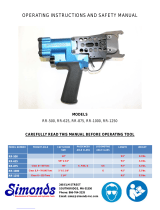
2
Proper Installation, Use, and Maintenance
Serious injury or death may result if gouging and cutting equipment is not properly installed,
used, and maintained. Misuse of this equipment and other unsafe practices can be hazard-
ous. The operator, supervisor, and helper must read and understand the following safety
warnings and instructions before installing or using any air carbon-arc torch or equipment.
The gouging/cutting process is used in many potentially dangerous environments, such as
elevated heights, areas with limited ventilation, close quarters, areas around water, hostile en-
vironments, etc. The operator must be aware of the dangers associated with working in these
types of conditions. The operator must be trained in safe practices for his work environment
and be under competent supervision.
It is essential that the operator, supervisor, and others in the work area be aware of the
dangers of the air carbon-arc process. Training and proper supervision are important for a
safe work place. Keep these instructions for future use. Additional recommended safety and
operating information is referenced in each section.
1.02 Electrodes
WARNING
ELECTRIC SHOCK CAN CAUSE INJURY OR DEATH
Install and maintain equipment in accordance with the National
Electrical Code (NFPA 70) and local codes. Do not service or repair
equipment with power ON. Do not operate equipment with protective
insulators or covers removed. Service or repair to equipment must be
done by qualied and/or trained personnel only.
Keep carbon electrodes dry. If electrodes become damp, bake them for 10 hours at 300˚ F
(176˚ C). Wet electrodes may shatter.
Do not touch electrically live parts. Do not touch an electrode with bare skin and electrical
ground at the same time. Always wear dry welding gloves that are in good condition. Alu-
minized, protective clothing can become part of the electrical path. Keep oxygen cylinders,
chains, wire ropes, cranes, hoists, and elevators away from any part of the electrical circuit.
Check all ground connections periodically to determine if they are mechanically strong and
electrically adequate for the required current.
If you are engaged in alternating current gouging/cutting under wet conditions or warm sur-
roundings where perspiration is a factor, use reliable automatic controls for reducing no load
voltage to reduce shock hazard. When the gouging/cutting process requires values of open
circuit voltages in alternating current machines higher than 80 volts, and direct current ma-
chines higher than 100 volts, take precautions, such as using adequate insulation, to prevent
the operator from making accidental contact with the high voltage.
If you are going to suspend gouging for any substantial period of time, such as during lunch or
overnight, remove all electrodes from the torch and the put the torch in a safe location so that
accidental contact cannot occur. Disconnect the torch from the power source when it is not in
use. Never immerse air carbon-arc torches or electrodes in water.






















